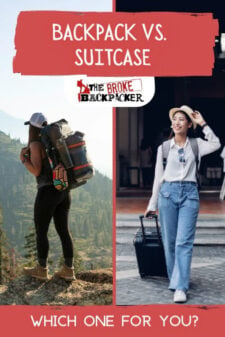We’re dedicated to broke backpacking, not broke rolling. Still, the answer might surprise you. The lines between backpacks and suitcases have grown fuzzy over the years as far-reaching destinations pave their roads and fix their potholes.
Thirty years ago, getting around without a porter or a backpack was much harder. Nowadays, a quick Google search can deliver airport pickup 4X4 safari vehicles. We can communicate worldwide in seconds to get to the mountaintop without getting our feet muddy.
Everyone setting out into a new continent or off-the-beaten-track used to have two choices: hardy backpacks made for hiking or traditional suitcases that aren’t any good off of flat ground.
Nobody was catching the chicken bus from town to town with a Samsunite.
As the world gets more accessible, luggage gets upgraded to stay relevant. Suitcases have gotten lighter, better at beating airline restrictions, and more durable. At the same time, the amount of backcountry has decreased worldwide, replaced by (sometimes horrifying) roads.
Backpackers just don’t have to walk as much anymore. In Peru right now, you can hop on a bus in Lima with better seats than any first-class airline, and it’ll drop you off after a good night’s sleep in reach of any hostel on the coast.
Things are getting more accessible, but we’ll all have to make a few long walks eventually. Twists, turns, and surprises are as natural to traveling as diarrhea. No suitcase beats a backpack when the bus drops you off on the wrong end of a dirt road through town.
Even as companies continue to bridge the gap, each particular style still has a solid niche. Wheeled luggage can’t hang with a great backpacking backpack, and no backpack makes it as easy as a briefcase to cross a border without a few extra questions.
There are serious consequences around the choice between backpacks and suitcases, and the days you reap those rewards will be some of the hardest of your whole travels. Getting ahead of a potential crisis starts with the right bag.
How to Choose Between a Backpack and a Suitcase
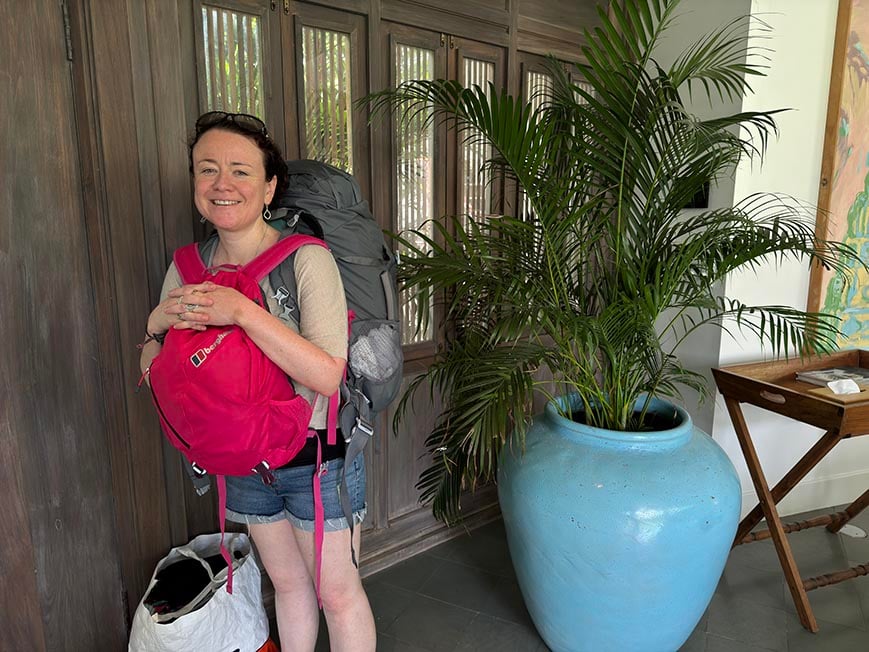
Image: Nic Hilditch-Short
Any vacation, whether it’s an hour’s drive or an overnight flight away, brings loads of variables. That’s why they can be so exciting, but it also makes it impossible to apply a one-size fits all solution.
Every destination or itinerary is perfect for every traveler; therefore, no suitcase or backpack works for everyone. Keeping up with the Joneses will only bring a sore back or keep you stuck on the curb. Over the coming sections, we’ll look at crucial aspects of your trip that will point you toward a particular travel style and empower you to go your own way.
Where Are You Going?

Image: Nic Hilditch-Short
Barefooted backpackers love to remind worrywarts that it’s about the journey, not the destination, but where you’re going matters. You need a rough draft of your trip sketched out before you know how to pack for it. At the same time, your bag must prepare for the likely possibility that things won’t go to plan.
Developed countries typically have space-age transit and fewer potholes on your way to your hotel, ideal for a smooth set of wheels. Other places can get quite creative when it comes to public transport. A malleable backpack with plenty of handles and attachments will have a much easier time fitting in.
While your chosen destination’s seat at the table is a factor, you shouldn’t assume a developed area is great for suitcases. Europe’s public transport and modernity embracing cobbled streets are great examples of human ingenuity, but they’re still better for backpacks.
Maybe you don’t know where you’re going yet, or all you know is that you’ll be going to multiple destinations – that still helps narrow things down. These key criteria will point you in the right direction.
What Kind of Trip Are You Taking?
Are you heading to one place for a week? Or spending months hopping from town to town?
Any trip where you’ll only unpack once will likely be a suitcase trip. Get to the hotel, unload your gear, slide the bag under the bed, and hit the pool. While several steps in that process are better with a beer in one hand, nothing there necessitates back pain.
A suitcase is a no-brainer for anything involving major airports, pre-arranged rides, and long-term rentals. However, the longer your trip is, and the more destinations you’ve got on the itinerary, the more powerful a backpack becomes. You can pack your backpack so that everything you need for a one-night stop is easily accessible and bounce from hostel to hostel for a week without entirely unpacking your bag.
Backpacks grow stronger the further away you get from baggage claim. No matter the distance you’re covering, daily or weekly movements will leave you tossing your suitcase in frustration after the third check-out.
What’s Your Travel Style?
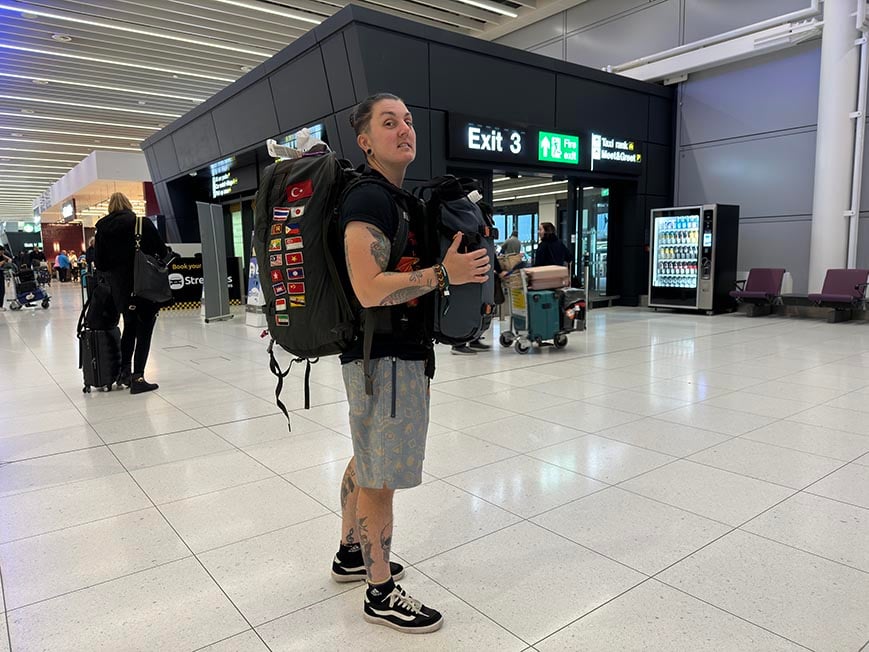
Image: Nic Hilditch-Short
Is someone going to meet you at the airport, or will you spend your first few minutes in a foreign country trying to figure out the bus system?
This crucial distinction practically points you toward a backpack or a suitcase on its own. You might not need a backpack if you never plan on maneuvering public transport systems or heading more than a few feet from your hotel without a driver or rental car.
However, if you’re favouring a few bus trips, you should expect to spend a few quality hours with your pack in your lap. A suitcase won’t serve well as a pillow. Backpacks help, whether you need a nap in the terminal or to run down the stairs and hop a turnstile to catch a train.
Your travel style won’t be exactly like anyone else’s. We’ve all got a few quirks that make up our travel style. The longer you prefer to stay in one spot, the more tempting a wheeled suitcase can become. As the itinerary starts to expand and the stops add up, life gets easier the less you’ve got holding you down to the ground.
What Are You Bringing?
Each baggage style is better for different kinds of trips and different kinds of luggage. High-tech camera equipment or designer suits require the wrinkle-free protection of a hard-shell suitcase. If you’re only packing a few shirts, shorts, and a pair of Havaianas, keep them on your shoulders and skip baggage claim.
Backpacks typically stick to nylon, staying lightweight and flexible. Suitcases on the other hand, can be tougher than turtle shells. Clothes, spiralizers, and paper can handle getting smashed around, but more sensitive packing lists might need a more robust outer layer.
That’s not to say that modern backpacks aren’t durable. Some bags can confidently handle both the mountaintop and the road’s bumps and bruises – they just won’t stand up the same to underappreciated baggage handlers.
Backpack’s loose straps, exterior pockets, and soft shell exteriors get them in trouble underneath the cabin. Regardless of which luggage style you choose, carry on any sensitive electronics or items you couldn’t live without for a week. Shaving a few pounds off your carry-on isn’t worth the risk.
The real question is, how much are you bringing?
Backpacks are going to be the stronger choice for one-bag travel, especially if your goal is to fit everything into the overhead compartment. Once the luggage adds up and it’s time to check a bag or two, suitcases simplify the process.
Backpack vs Suitcase – Pros and Cons
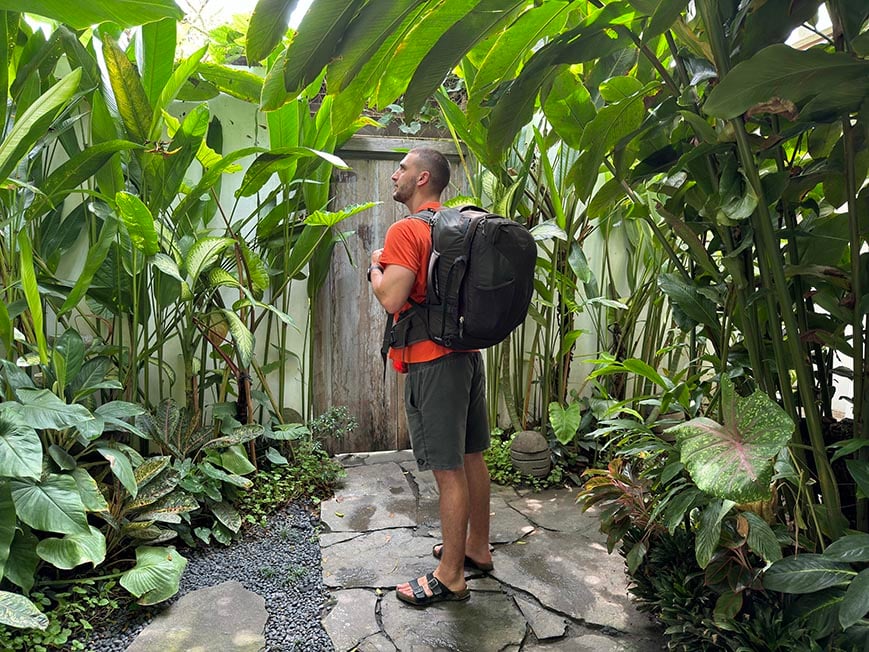
Image: Nic Hilditch-Short
These bags serve as each other’s foils. Many of a backpack’s greatest strengths are a suitcase’s worst nightmare, and vice versa. Breaking down the pros and cons is the simplest way to see the stark differences between the two.
Backpacks
Backpacks are as easy to support on solid earth as they are over rocky terrain, but that doesn’t mean it’ll always be a simple task. Everything you bring you’ll have to drag on your shoulders every step of the way.
Pros
Using a backpack and packing light is the traveling equivalent of teaching a Pokemon cut: the right gear can get you off the paved roads and explore all sorts of hidden corners.
Easy to carry
Whether heading down to the subway or sprinting up the terminal, you won’t have to worry about your backpack getting in the way. Plus, finding solitude will require some off-roading. Any piece of luggage can bring you to a resort, but only a few solid backpacks will let you sleep soundly in the backcountry.
Great for walking
There is no point in packing boots made for walking if your luggage isn’t. You don’t have to be scaling a mountain to enjoy the hands-free carry style of a backpack. Suspension systems always beat out luggage handles in the long haul. Anyone walking beyond the quick trip from the terminal to a taxi will enjoy the smoothness of backpacks.
Lighter
Suitcases don’t consider weight the same way a backpack does. Design teams have spent decades figuring out bags that store more while shaving off precious pounds. Not only does this save some strain on your back muscles, but it also allows you to pack more gear while staying under strict weight limits.
Compressible
Alongside those weight limits are even more oppressive dimension requirements. Sometimes I arrive at the airport an extra 30 minutes early just to stuff my backpack down through minute metal bars and show the check-in counter my big bag can still fly. If your bag is under 50 Liters, there’s always a way to make it fit, as long as you avoid Ryanair.
Resilient and repairable
Especially backed with REI’s impressive return policy or Osprey’s All-Mighty Guarantee, your backpack may be the last one you ever buy. A great backpack is eager to get the absolute, ever-loving shit kicked out of it and still zip close without a fuss.
Cons
Choosing a backpack forces you to consider every ounce, but some vacations are more fun with some extra toys. A fully loaded hiking backpack would also be overkill on a week-long beach trip.
You have to carry all on your back
The carefree nature of backpacking is all fun and games until you get a few miles underneath your feet. You might not notice an extra pound or two the night before you leave, but you’ll be about ready to throw half your belongings over the bridge after your bus drops you off on the other side of town from your hostel.
Can be awkward to pack and unpack
Lots of bags are organised when you leave the house, but chaos reigns in most main compartments after months of new towns. Top-loading Backpacks that store everything in one main compartment will quickly feel like black holes.
A great backpack will bring a full, clamshell-style opening to make things easier, and packing cubes take your packability a step further. You can coordinate your cubes in a way that will pack everything you need for a quick stop on top and keep your dirty laundry away from your last clean underwear.
Belongings not protected
Brands favor nylon for a lightweight, weather-resistant exterior, but the material doesn’t offer much shock protection. Anything stored inside your backpack will be squeezed, squished, and squashed somewhere along the way. Clothes will be wrinkled, bananas will be squished, and fragile equipment might need more than a softshell bag to survive.
Can hurt your back
If you are traveling with a backpack, trust a broke backpacker when they tell you it’s worth the extra money for a proper suspension system. No good story starts with back pain.
Still, you’ve got to carry every pound you pack. Even backpacking specialists with sternum and hip belts will weigh you down eventually.
Suitcase
While they can’t handle many different terrain types, suitcases roll along airport terminals and smooth pavement lighter than air.
Pros
There is nothing better than a suitcase to get you through a few flights with your clothes still fresh and your shoulders loose.
Wheelable
Do not underestimate the benefit of a great set of wheels. Any backpacker is lying if they tell you they aren’t a bit jealous when they watch wheeled suitcases set off after security. There’s a reason why you’ll never see a flight attendant or pilot with a backpack – wheels are the way to get through airports fast.
Hard Shells protect gear
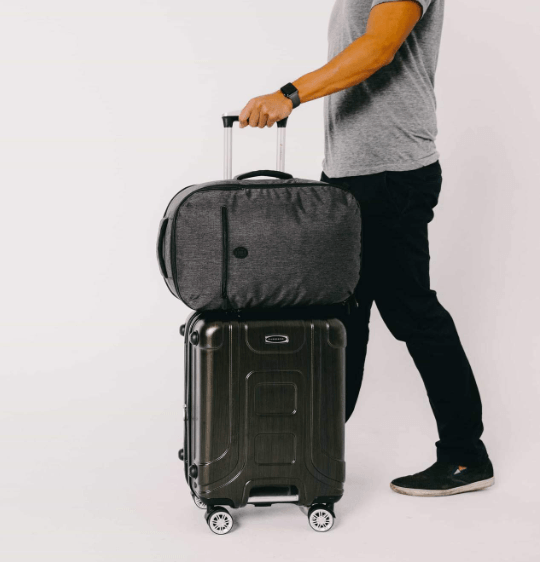
Some suitcases are practically bulletproof. The rigid plastic exterior of most wheeled bags serves two main functions. They can handle being thrown around by baggage handlers, and they’ll keep your gear in one piece even if your bag is at the bottom of a heavy pile of luggage.
Organisation
Backpacks may come with more pockets, but suitcase’s large openings and solid corners open up your storage capability. You can fully unzip a decent-wheeled bag and easily get to your toothpaste at the airport.
Still, look for models with exterior zippered pockets for easy access to the little things.
Waterproof
Backpacks have a few tricks up their sleeves, or raincoats ready for deployment, but a military-grade suitcase still provides the most waterproof way to reach your final destination.
Cons
Suitcases struggle mightly to get out of their comfort zones.
Wheeling is not ideal everywhere
Off of smooth surfaces, those wheels do nothing but get in the way. Suitcases are often awkward to lift and carry more than a few feet. You can either stubbornly drag your wheels along the aging infrastructure outside the airport or admit defeat and pay for a taxi.
You look a like a tourist
When rolling a suitcase around most cities, you won’t make it more than a few blocks without someone trying to make some money off you. Before you get off the plane, prepare to be greeted by “taxi?” a few dozen times.
Hard to lift
Don’t plan on lifting your suitcase much further than from the floor onto the scale at check-in. It’s easy enough to get a smaller wheeled bag up to the overhead compartment and back, but as your travel day drags on any effort can feel like an Olympic task.
Pretty soon you may be making eyes at your seatmate to help you lug your bag down. Eventually, A fully packed bag at the bottom of a steep set of stairs can have you considering turning around and going home.
Can’t be squashed
Hardshell suitcases stay one size for their entire existence. This is excellent news for the suitcoat your luggage protects, but it’s not always ideal for the overhead compartment, and it makes them almost impossible to fit on the back of a camel.
Heavy even unpacked
All those extra bells, wheels, and whistles are great for taking the weight off and protecting your gear, but they don’t come without costs. A big and bulky suitcase will be almost as annoying to maneuver without anything inside.
How About Both? Introducing the Backpack Suitcase Hybrid
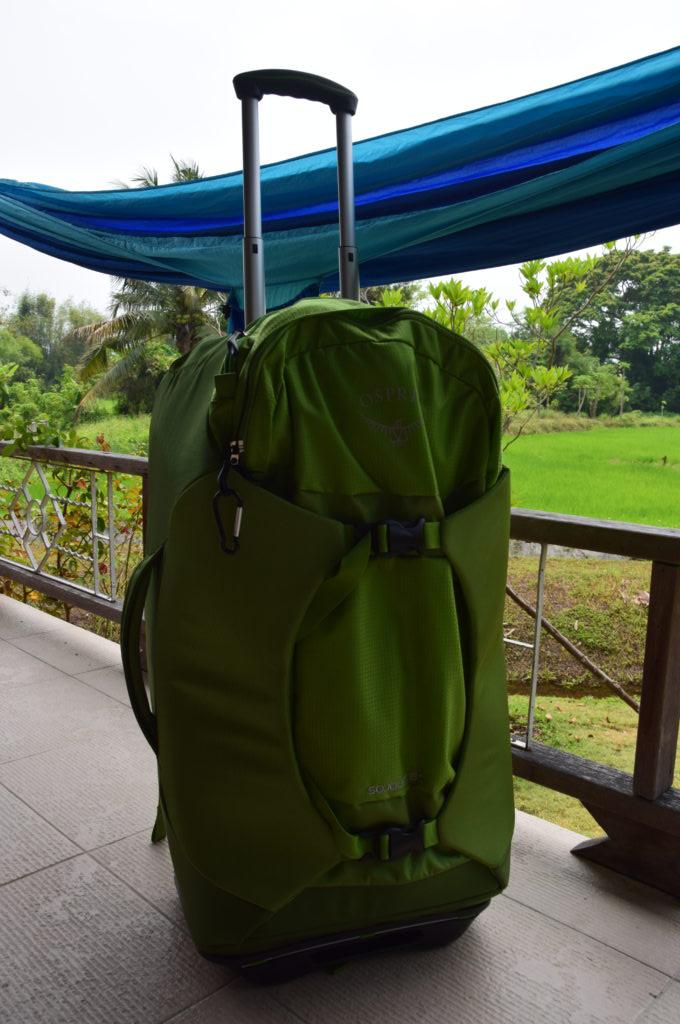
The appeal is simple: while there are always situations where you need a backpack (cobblestone streets, rainy seasons, crowded buses), there are also plenty of times when you don’t. You can sometimes feel silly walking around airports with a fully loaded pack on your back while everyone else is wheeling their way through the food court. So why not have both?
A backpack suitcase hybrid weighs less than your traditional suitcase, while providing the weightlessness in travel a traditional backpack can’t offer. You’ll have those few extra exterior pockets and straps that backpacks are great for, plus the handles and wheels that help suitcases save backs.
On paper, a backpack suitcase hybrid could dominate the industry. Every traveler dreams of a lightweight, nylon bag that they can throw over their shoulders as easily as they can wheel it with one hand.
Unfortunately, a jack of all trades is often a master of none. The main sticking point to these hybrids is the extra weight. Even our favorite Hybrid, the Osprey Sojourn 60L, still weighs an extra 1.5 kilos compared to the Osprey Aether 60L. An extra kilo in a full 60-liter backpack can be a death sentence.
This system still has a few kinks to work out, but we’ve got our best people on it. For now, these hybrids are more suitcases than backpacks, and none of them are ready for the backcountry. Still, this system has loads of potential, which might already be ready to replace traditional suitcases.
Not convinced? Why not check out some of the best wheeled duffels instead?
The Best Backpacks and Suitcases That Your Money Can Buy
No matter your preferred style, these four are the best in class.
Osprey Aether
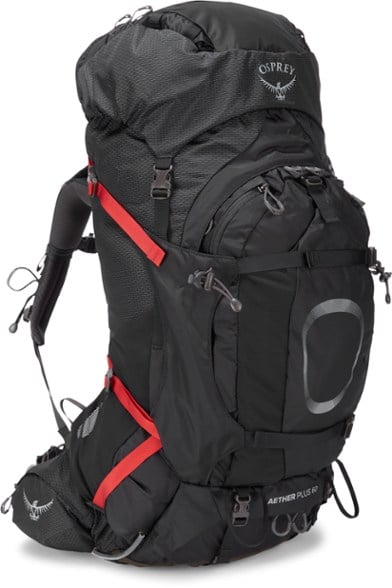
No backpack is more comfortable in more scenarios than the Osprey Aether. You can select from the slim 55L, which has space for a three-day weekend in the backcountry, opt for the Ariel women’s version, or go big with the 70L version that adds on a removable daypack.
The backpack brings loads of backcountry expertise to trips off and on the beaten path. Loads of external attachment points and a thick mesh pocket bring plenty of space for travel snacks.
These hooks and handles help the bag lift easily both on top of tuk-tuks and off the carousel. Unfortunately, no model smaller than 70-liter version comes with the removable daypack, and 70 liters is too much for most trips. Still, the exhausting list of extra features put this pack squarely in the mix for overnight hiking trips and international expeditions.
Nomatic Travel Pack
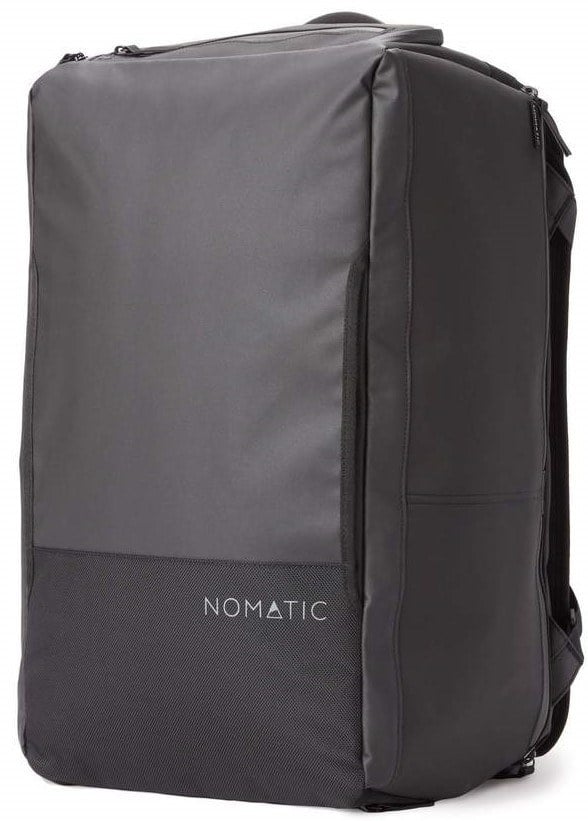
You could make the case that this sleek travel pack is the closest thing to a hybrid backpack suitcase on the market that doesn’t include wheels. This combination backpack and duffel bag wears like a backpacker and packs like a suitcase to make the most of 40 Liters.
It delicately walks the line, providing the most storage possible while staying underneath carry-on limits. A bag this big can sometimes feel like a bottomless pit, but Nomatic’s travel pack brings a wide clamshell zipper and a whole lot of compartmentalizing to the table.
Between an included laundry bag, shoe compartment, exterior tech storage, and a water bottle holder, Nomatic has a plan for everything. The ergonomic space allows you to pack an extra change of clothes and still have room for souvenirs. That extra effort is why this Kickstarter darling became a top travel pack for long weekends, week-long trips, and open-ended getaways.
Nomatic Roller
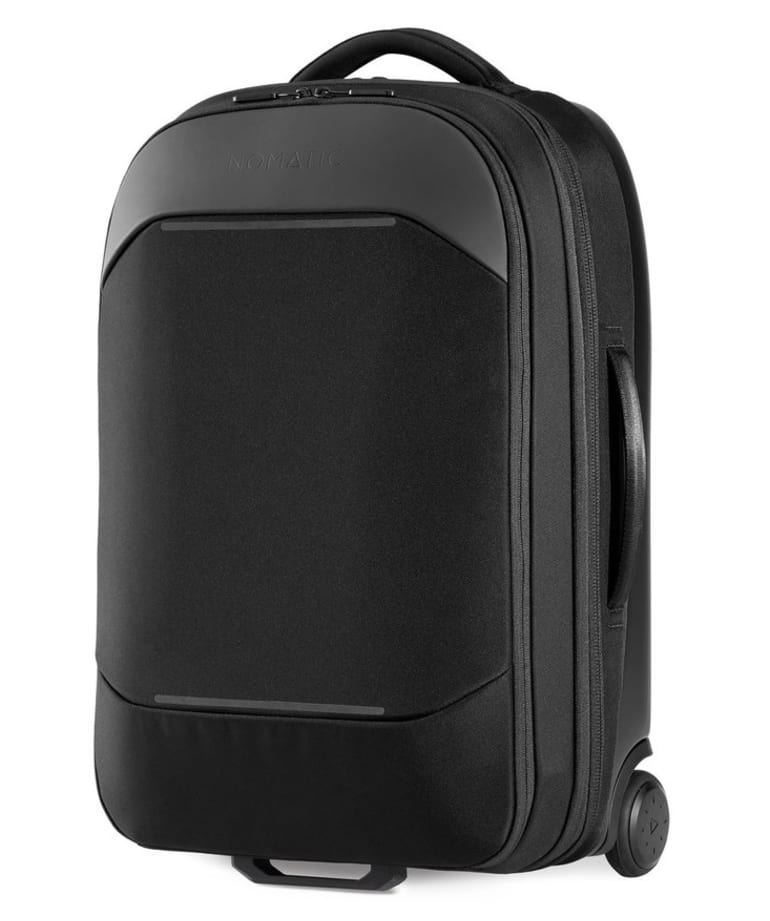
Nomatic branched out from one-bag travel into the business world with this sleek Navigator 37L Roller. The company developed a reputation for adding loads of utilities into traditional models and brought those efforts into hard shells.
The result is a classic suitcase with several tricks up its sleeve. For starters, this roller is incredibly carry-on friendly, squeezing 37L of storage into a compact size. They even accented the edges to ensure the bag slides easily into cramped bins. It’s incredibly sleek on the outside and the inside is packed full of special features that maximize packability.
You won’t find many suitcases on the market that can rival this roller’s easy access. An external laptop compartment and stealthy stowage for your passport, keys, and phone go a long way on travel days. The entire hardshell comprises Makrolon Polycarbonate to finish off a suitcase that redefines the category.
Osprey Farpoint 65
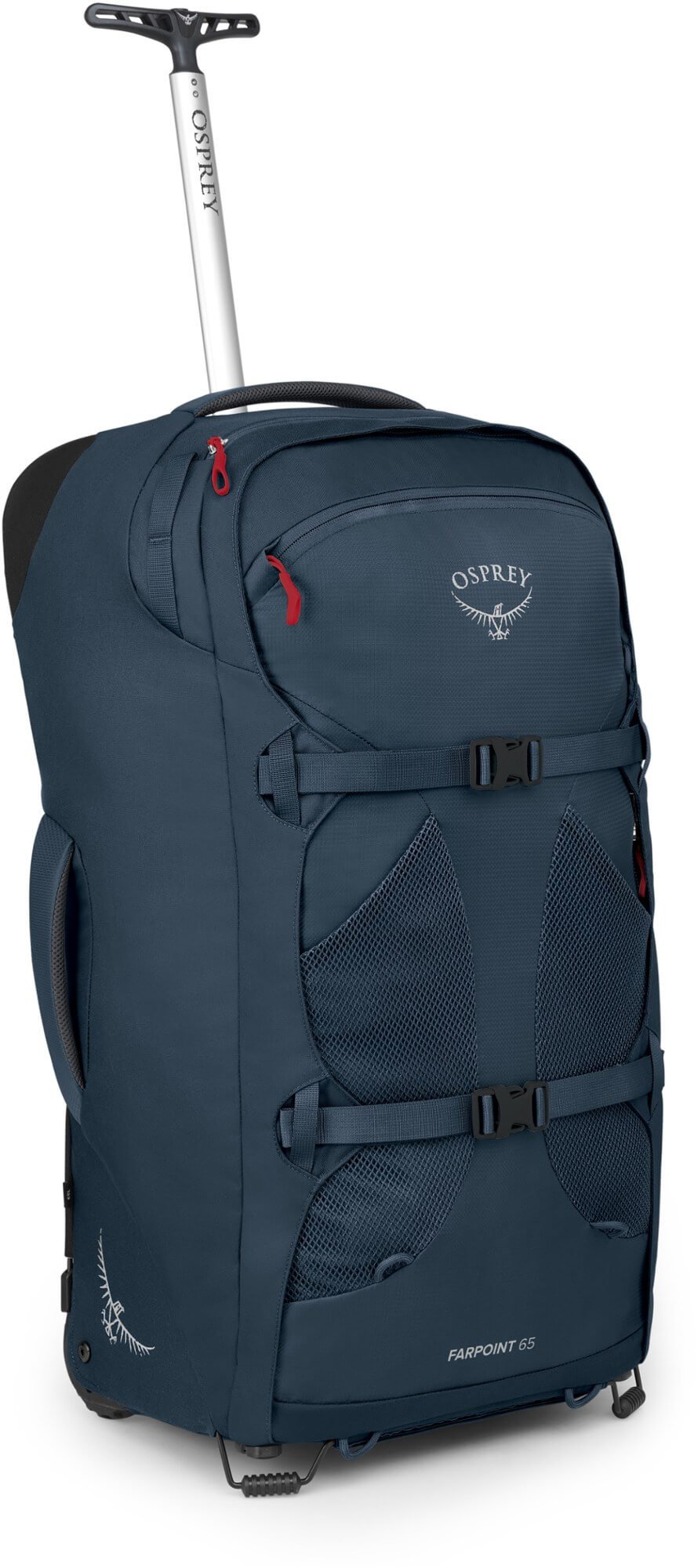
Hybrid suitcase backpack models still have a ways to go before they can replace backpacks, but they’re already starting to disrupt the traditional suitcase industry. At the front of the charge is Osprey, who has churned out a few bags that try to provide the best of both worlds, none more successfully than the Farpoint.
There are still a few kinks to work out in this category: The Farpoint comes with stowable hip and sternum straps to help out, but it’s still a heavy weight to bear fully loaded, and it doesn’t come with the same adjustability as other Ospreys. The wheelie system is durable, but to save a few precious ounces, the handle on the suitcase doesn’t extend as far as a traditional case.
It’s not perfect, but no one bag is. This beast brings plenty to the table with its immense clamshell-style opening. The U-shaped lid features a zippered mesh pocket along its entire length, a clutch spot for keys, trinkets, and doodads you don’t want to get mixed up with the rest of your gear.
Osprey backpacks are great for the modern world, but the company initially set out to make gear for the backcountry. That pays dividends in this sleek suitcase, with a reinforced aluminum frame and hardcore 90 mm wheels. This is one set of wheels that won’t break down at the first sign of trouble.
Final Thoughts on Backpacks vs Suitcases
Let your itinerary make the final call. Backpacks are growing more technically savvy, but they crave the great outdoors. Suitcases, on the other hand, live for the terminals. If you know you’re packing it all up in a bag and going but aren’t sure where that’s still an important piece of the puzzle.
Ask yourself how much time you plan on spending outside with your luggage on your next trip. Not just in national parks but waiting for buses, walking from stations to hotels, and bouncing from town to town.
The more unknown the itinerary, the better off you are bringing a backpack. The convenience will outweigh the frustration once your back adjusts to the load. Keep the packing list light, and backpacks will give you greater freedom to roam.
On the other hand, trips that require straight collars, single hotel reservations, and expensive equipment pair well with four wheels and a retractable handle. Hardshell suitcases, (and a juiced-up set of Airtags) eliminate as many variables as possible in dramatic airport baggage claims to bring more peace of mind to your travel days.
If you’ve got a home base and know that traveling is about to be a significant part of your life, you should consider investing in a suitcase and a backpack. That way, you’ll be equally prepared for a weekend trip to visit the family, as you will for a month-long foray into the jungle.

And for transparency’s sake, please know that some of the links in our content are affiliate links. That means that if you book your accommodation, buy your gear, or sort your insurance through our link, we earn a small commission (at no extra cost to you). That said, we only link to the gear we trust and never recommend services we don’t believe are up to scratch. Again, thank you!



